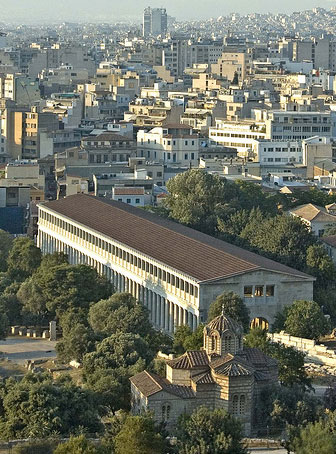
Stoa of Attalos Athens
You will find the Stoa of Attalos inside the ancient Agora of Athens. It took its name after the King of Pergamon called Attalos II who ruled from 159 till 138 BC and it was given to the Athenians as a gift in exchange to the education that Pergamon received there. The reason why the stoa (archway) stood out from the other ancient Athenian buildings of the time was that it was bigger and more elaborate, made of Pentelic marble and limestone. It is actually a two-storey building 116 m x 19.4 m. On the ground floor there is a Doric colonnade and an Ionic upper colonnade incorporating a balustrade. The fašade is all marble and each story had two aisles and twenty-one rooms lining the western wall. All the rooms had doors and windows on the back wall used for lighting and ventilation and a stair was leading up the second floor. The archway of Attalus looked a lot like the stoa of king Evmenes II (who was the brother of Attalos) located on the south slope of the Acropolis next to the theatre of Dionysus. The only difference was that the one of Attalos had several rooms on the ground floor used as shops.
The stoa of Attalos was frequently used before its destruction in 267 by the Heruli but it was reconstructed during the 1950s and turned into the Ancient Agora Museum with the help of funds provided by the Rockefeller family. Because of the fact that this building is an excellent replica of the original it plays an important role in the study of ancient Greek monuments.
The Treaty of Accession (16 April 2003) was signed inside the Stoa of Attalos and 10 countries, such as Cyprus, Hungary, Malta, Poland and more, participated.
